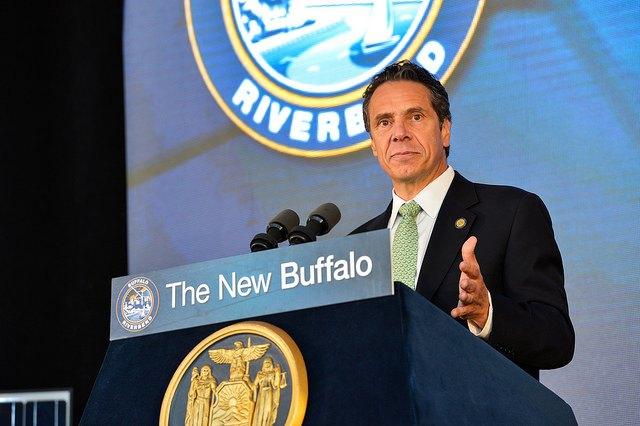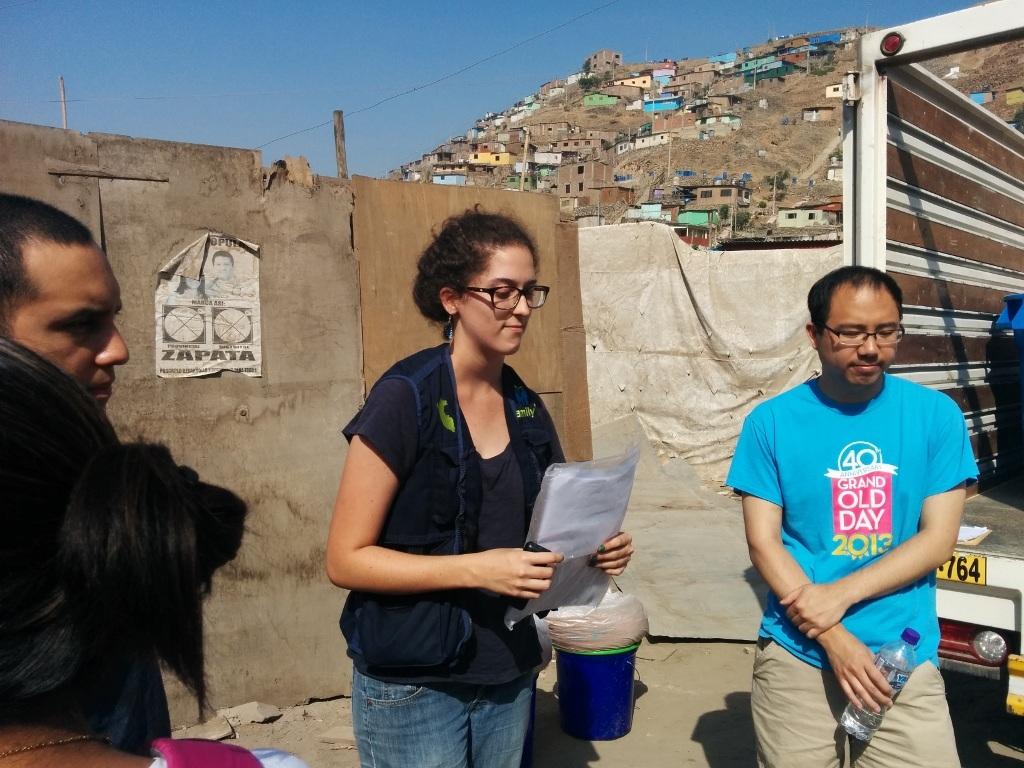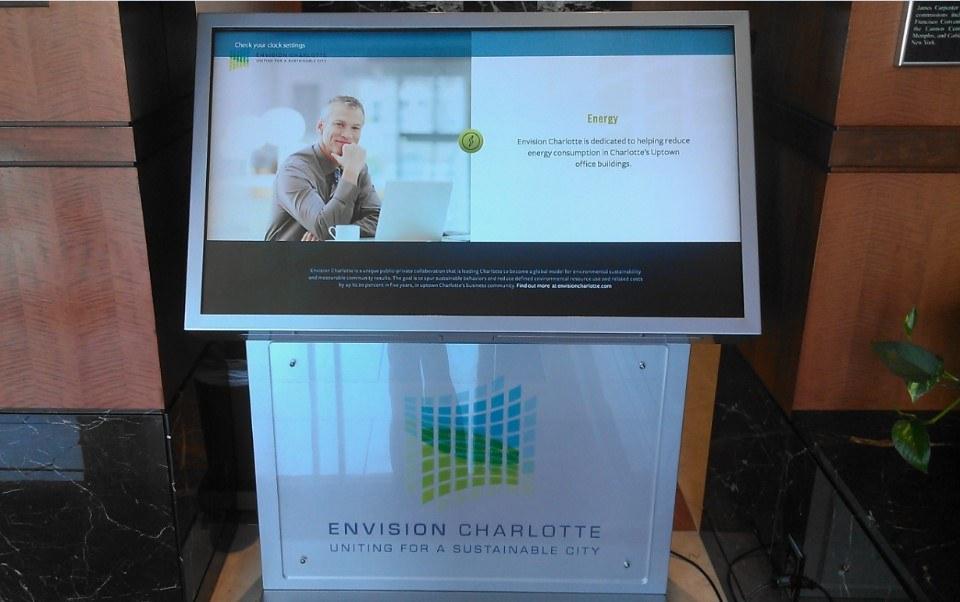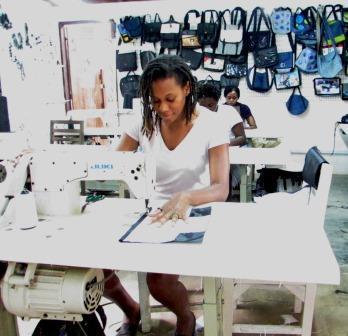SolarCity’s Buffalo Boom Brightens Local Economy


If you think the idea of a new, clean-energy economy or the notion of green jobs are just rhetoric, take a trip up to Buffalo, New York. Have a look at the 1.2 million-square-foot shell of SolarCity's recently-completed manufacturing plant that lies nestled in a crook in the Buffalo River, just a mile or so before it empties out into Lake Erie.
The plant was topped off this week, a milestone that was marked by a visit by Gov. Andrew Cuomo. The $900 million factory is the centerpiece of the governor’s upstate economic development plan, that he calls the Buffalo Billion. Other developments in the area include an IBM software research facility and biotech offices for Albany Molecular Research.
The new SolarCity factory is the result of a public-private partnership -- in which the state retains ownership of the plant and machinery to discourage the company from moving out, in an environment where states are competing heavily against one another to attract businesses. The Buffalo area lost 10,000 manufacturing jobs over the past decade. The deal also contains a clause that requires the company pay significant fines if projected employment levels aren’t met.
The project, which is the largest in Buffalo’s history, is ahead of schedule. The plant is expected to be operational in early 2017. By that time it will employ some 3,000 workers, spinning off another 2,000 supporting roles in the local economy. That’s enough to drop the region’s unemployment rate by a full percentage point. Hiring begins this fall.
The project could be considered a case study in reversing recent economic trends. Not only is the plant being built on the site of the long-shuttered Republic Steel plant, but, with it, the company will insource its solar panels, rather than purchase them from other suppliers. Last week, SolarCity announced a new financing program to boost solar sales among small- and medium-sized businesses.
The plant is expected to produce 1 gigawatt of solar capacity per year, slightly more than the company currently buys from suppliers. SolarCity CEO Lyndon Rives said, "My goal would be to do 5 gigawatts after this one." An additional site would be required for that, and speculation is that it would be someplace nearby. "It sets up the state to be the solar capital of the country. It creates manufacturing, it creates a market, and it creates infrastructure for how clean-energy companies will work together.''
The new panels will be based on technology from Silevo, a company that SolarCity bought last year. Silevo's panels, which utilize a proprietary device architecture, deliver a higher voltage and have demonstrated efficiency as high a 24 percent. With higher efficiency, fewer modules are needed for a given power level, leading to reduced cost.
Momentum for alternatives to fossil fuels continues to build as President Barack Obama and the EPA recently announced a finalized Clean Power Plan that will provide incentives for states to move away from carbon-emitting power generation. The plan calls for a 32 percent reduction of carbon emissions relative to a 2005 baseline.
Image credit: Flickr/governorandrewcuomo
Setting Goals for Diversity: The Silicon Valley Challenge
With just over 47 million unique visitors a month, Pinterest is far from the largest social media company. Compared with Facebook's 1.4 billion, Whatsapp's 700 million and LinkedIn's 347 million, Pinterest still has a way to go as a Silicon Valley giant.
But it has managed to do something that its tech neighbors haven't: It developed its own metrics and goals for diversity.
Silicon Valley companies have been under pressure to increase their diversity numbers for a while now. This week that spotlight got a bit hotter when members of the Congressional Black Caucus paid a visit to the area to find out why diversity seems to be such a problem in California's tech epicenter.
African American employees account for just 2 percent of Google's workforce. Hispanic representation is similar, at 3 percent, while Caucasian workers account for more than 60 percent of the company's tech labor.
Apple's diversity representation is better, but still reflects a confusing lack of diversity, with African American and Hispanic employees at the bottom end of the spectrum, 7 percent and 11 percent respectively.
Both companies point out another glaring inequity on their blogs: the ratio between men and women. Seventy percent of workers in both companies are men.
It's no surprise that tech companies are looking at this problem. Their users and a variety of advocacy groups are as well. According to the Computing Research Association, 4.5 percent of computer science and engineering graduates in 2013 were African American. More than 6 percent were Hispanic, leaving a gaping hole between those hired and those with related degrees.
Pinterest's stats aren't much better. While 61 percent of its tech workforce is Asian (and 34 percent are Caucasian), roughly 3 percent are Hispanic and 1 percent are African American. As for gender, 82 percent are male, and 18 percent are female, paving a path for Pinterest's recent announcement that it would implement new diversity goals for 2016.
The company's strategy includes expanding its recruiting locations, raising its percentage of female tech workers to 30 percent from 18, and boosting its stats for non-Caucasian workers to 8 percent.
While it hasn't gone into the deets as to how it will make these sweeping changes, Pinterest (and Facebook as well, incidentally) have acknowledged that increasing diversity means increasing diverse representation at management levels as well. Both companies have announced that they will implement "Rooney's Rule" when interviewing potential leadership candidates. The concept is named after the former chairman of the Pittsburgh Steelers, Dan Rooney, who took steps to ensure that the NFL team interviewed minorities as a matter of course for coaching positions. It was a revolutionary concept when he implemented it, and it helped change the culture of NFL leadership.
In an age when diversity is fortunately becoming a boardroom action point, these companies should have no problem coming up with proven steps to improve their numbers. Simply stating that they will increase the hiring of other backgrounds, however, leaves the potential for perpetuating the often unintentional appearance of passing up one candidate for another just because of color.
Other organizations like MGM Resorts, which we wrote on recently, have developed innovative measures to increase diversity in their ranks. The lesson that seems to come through their efforts suggests that successful diversity initiatives aren't just mastered by who is hired but by the breadth of the programs that inspire social change, such as community networks that work for inclusiveness, mentoring and sponsorship programs and, as Pinterest pointed out, a very broad recruiting system that captures the vision of a diverse cross-section of applicants, and a wide spectrum of diverse points of view.
Maybe companies like Apple, Google, Facebook and Pinterest will develop their own list of must-dos that will help other companies understand the complexities that go into increasing ethnic, gender and leadership diversity. No company is the same when it comes to culture or expertise, but as studies now show, the reasons for increasing diversity aren't just humane or ethically driven. They are economically driven -- not to mention good business.
Social media logos: Roy Blumenthal; San Francisco Bay Area: Craig Howell
Court Strikes Down Idaho Ag-Gag Law


When animal rights abuses occur on factory farms, chances are great we know about them because some brave soul went undercover. Using hidden cameras, activists take jobs at factory farms and blow the whistle on abuses. Unfortunately, some states have what is termed “ag-gag laws,” which make it illegal to conduct undercover investigations at farms.
Thankfully, activists in Idaho can still conduct investigations. The U.S. District Court for the District of Idaho recently struck down the state’s ag-gag law, ruling it is unconstitutional. The court held that the law violates first and 14th amendments of the U.S. Constitution. The decision marks the first time a court ruled that an ag-gag law is unconstitutional.
Here are a few details about the Idaho court case. Don’t keep reading if you are the squeamish type. Some of the details are downright revolting. In 2014, an animal rights group, Mercy for Animals, released of video of workers using a moving tractor to drag a cow on the floor by an attached chain around her neck. The video also showed the workers repeatedly, beating, kicking and jumping on cows. Undercover Mercy for Animals activists secretly recorded the video at the Bettencourt Dairies’ Dry Creek Dairy in Hansen, Idaho. The video went viral, drawing national attention.
The Idaho Dairymen’s Association, a trade organization representing dairy farmers and producers in the state, drafted and sponsored an ag-gag bill. The bill made it illegal to conduct the type of undercover investigations that revealed the abuses at the Idaho dairy. The Idaho state legislature passed the bill. The Animal Legal Defense Fund (ALDF), along with other animal welfare organizations, challenged the bill in court as being unconstitutional.
A similar case is pending in federal court in Utah, which also has an ag-gag law in place. In 2013, Amy Meyer recorded a video at Dale Smith Meatpacking Co. in Draper, Utah, of a sick cow being moved by a bulldozer. In the video, Meyer is heard exclaiming, “The cow on that bulldozer is alive!” Meyer was charged under the state’s ag-gag law, but the charges were dropped. Meyer, ALDF, PETA and an undercover investigator filed a lawsuit challenging the state’s ag-gag law.
What undercover investigations reveal
Severe animal abuse has been discovered at factory farms through undercover investigations like the one conducted by Mercy for Animals. Investigations have also revealed the presence of antibiotic-resistant “superbugs,” chickens abandoned by the thousands and left to starve, and pregnant and nursing pigs housed in gestation crates where they can’t even turn around.
“Undercover investigations have revealed the dark world of animal abuse and health and safety violations on factory farms — such as workers kicking, punching, and dragging cows, pigs, and chickens,” wrote Stephen Wells, ALDF’s executive director, in a blog post back in 2013. “These investigations have resulted in criminal convictions, national meat recalls, plant closures, and civil lawsuits — all of which makes undercover investigations and reporting an absolute necessity for protecting animals and public health and safety.”
In other words, undercover investigations have been good for the animals on factory farms and the humans that eat them. Since many of us just don’t want to be vegetarians, making sure that farm animals are treated as humanely as possible is important. What does it say about a society that mistreats its animals?
Image credit: Mercy for Animals
Biodegradable Batteries ... For Real?


By Anuradha Wadhwani
Batteries are poised to become the heroes of the future -- in consumer electronics, vehicles and now homes. But it’s not just the applications of batteries that are advancing; expectations about battery capacities have soared to unprecedented levels. Energy-guzzling electronics are constantly hungry for power, and the more rechargeable battery technologies we have, the better.
But this is an area where environmental agencies are urging companies to tread with care. Most batteries contain heavy metals that harm our health and the environment. While Americans purchase an estimated 3 billion dry-cell batteries annually, the European Commission says: “Every year, approximately 800,000 tons of automotive batteries, 190,000 tons of industrial batteries, and 160,000 tons of consumer batteries enter the European Union.” Although thousands of tons of these batteries end up in landfill sites each year, recycling rates remain disappointingly low.
Interestingly, this also points toward a white space that is now attracting some attention: bio-batteries. The term refers to batteries that contain no toxic materials and are biodegradable. The interest in biodegradable batteries has been building up for a while now. Biologists and scientists have realized that many naturally-occurring materials can store and release energy for modern-world applications, such as smartphones, laptops, wearable electronics and medical devices.
Car electronics and textiles powered by all-natural, biodegradable batteries
A team of researchers from Sweden’s KTH Royal Institute of Technology collaborated with their counterparts at Stanford University to use wood fiber to develop a battery. The results, published in June, were immensely encouraging. The team was able to successfully develop soft, elastic batteries with surprisingly high capacities using nanocellulose derived from tree fibers. The researchers say that the ‘aerogel’ material will find uses in vehicles and clothing.
Last year, researchers at Virginia Tech found sweet success with a bio-battery that’s powered by sugar – an energy-storage powerhouse. What’s equally fascinating is that this refillable battery is 10 times more energy-dense than a lithium-ion battery of the same size. From cell phones to video games to tablets, the sugar-powered battery could hit the commercial electronics market in about three years, says associate professor Y.H. Percival Zhang, who spearheaded the project.
In June engineer Seokheun Choi, from the University of Binghamton, used something more abundant than sugar to reach a new milestone in battery technology: microbes. He applied the Japanese art of origami to build a battery that draws energy from microbial respiration. Dirty water, which teems with organic matter, works like a charm on this battery, Choi says. A single drop of dirty water can generate enough power for a biosensor. For five cents a piece, the battery could be a game-changer if it is successfully commercialized.
Biodegradable batteries that could revolutionize drug delivery
Imagine a tiny battery that travels through the body, administers a precise drug dose at the desired location, and disintegrates without a trace. In a few years from now, drug delivery, as we know it today, will never be the same.
Researchers led by Professor John Rogers at the University of Illinois have developed a biodegradable battery containing magnesium, tungsten, iron and molybdenum that can deliver drugs or wirelessly send data to an external device as it travels through the body. The biodegradable polymer-coated battery then dissolves gradually without any harmful effects.
At Carnegie Mellon University, researchers used cuttlefish ink to develop fully-biodegradable sodium-ion batteries that they describe as "edible." Professors Chris Bettinger and Jay Whitacre say that the battery, which is about the size of an average pill, expands in size only when it reaches the desired location within the body thanks to its shape-memory polymer. And because it is so versatile, the battery could go much beyond drug delivery and fit perfectly in applications such as this biodegradable drone from NASA.
If these ideas are successful outside of a laboratory, they could revolutionize the very concept of ‘clean’ technology innovations. But that’s precisely where the problem lies: Bio-battery innovations have thus far been limited to laboratories. Unless these innovations from academic institutions find a commercial launch-pad sooner, it will be at least a decade before any real progress is made.
Image credits: 1) KTH Royal Institute of Technology; 2) Binghamton University; 3) Carnegie Mellon University
Having extensively worked as a journalist with leading national dailies in India, Anuradha Wadhwani now writes for market intelligence firm Transparency Market Research. Anuradha is passionate about tracking (and questioning!) market trends across areas such as sustainability, innovative materials, and chemicals.
Visualizing Climate Change with Virtual Reality


By Emma Bailey
As the years pass, and the reality of anthropogenic climate change has become widely accepted within the scientific community, most regular citizens still lack a sophisticated understanding of the scientific factors at play in global warming. Recognizing the need to communicate the severity of current circumstances, scientists are looking to new technology to help broaden awareness of the global issue. Virtual reality, back in the spotlight after years in relative obscurity, has already proven to be a powerful tool in getting people to rethink their relationship to the planet and its resources.
A few halting steps were taken toward virtual reality between the '60s and '80s. A fully mechanical “Sensorama” offered smell and touch stimuli while subjects watched short films, and early flight simulators strove to create as immersive an environment as possible. These laughably crude efforts paved the way for further developments in the '90s, which actually saw a few production devices reach market. Unfortunately, the hardware of the time was not powerful enough to create fully engaging virtual environments, and most of the products on offer flopped hard.
Virtual reality had almost entirely disappeared from the mainstream until just a few years ago, when the Oculus Rift began developing in earnest. Realizing the potential of this new technology, social media giant Facebook acquired it from its initial developers for $2 billion in early 2014. A consumer version is expected to be unveiled in 2016. Microsoft didn’t take that news lying down and intends to introduce a competing system, called HoloLens, also in 2016. Sony's game-oriented Project Morpheus is expected to hit the shelves in the same year. Furthermore, as these three companies go head-to-head in other aspects of tech enterprise -- such as the development of new satellite Internet solutions and advanced social search algorithms -- we can expect the virtual reality space to yield increasingly innovative results as well.
Climate change, like many large-scale issues, is a dilemma which most people feel is outside of their direct control. However, public inaction and lack of support for certain environmental policies over the long term creates a dangerous disconnect. However, significant research has shown that the introduction of market-ready virtual reality (VR) devices could be important in visualizing for a lay audience the consequences of environmental degradation. This is a topic that's hard to intuitively grasp for most people because the dangers will only manifest themselves slowly over a period of decades. By harnessing the possibilities of virtual reality, environmental advocates can make the subject real to millions of people whose only knowledge of environmental abuses and climate change has hitherto been abstract and theoretical.
There have already been some significant in developments made in this area. Although VR headsets aren't available to the general public as yet, researchers have been able to conduct a variety of experiments using prototype or custom hardware. At Stanford University’s Virtual Human Interaction Lab, scientists are striving to “design, test, and distribute virtual reality interventions that teach the concept of empathy.” Cultivating “effective altruism” in any context is a difficult task, but mirroring the emotions of the environment is almost impossible for a species that has been raised to see reality as a bounty to be harvested without remorse.
In an earlier experiment, the lab initiated a project in which participants either cropped down a virtual tree or read about the experience in a detailed description. In following tests, those that took part in the VR simulation reduced their usage of paper products by 20 percent in comparison to those who did not. In another experiment, test subjects were asked to virtually eat coal while bathing in order to fully understand the amount of resources they require to enjoy a hot shower. Beginning last year the lab took their research under the sea, using virtual reality helmets to immerse participants in the reality of ocean acidification. Across these simulations, it was determined that even after the experiment was complete, the change in attitude towards the environment among participants remained.
Besides placing people in imaginary situations, virtual reality can turn people into witnesses to events thousands of miles away. In the nascent field of virtual reality news reporting, the Des Moines Register has achieved a startling success. It used VR mechanisms to cover the history of a local farm and the numerous economic and environmental challenges faced by the family in ownership. The story got more than 400,000 page-views, an order of magnitude more than most popular traditional news articles. If a regional outlet like the Register can draw in such an audience, we can only imagine what kind of numbers the New York Times or Chicago Tribune would be able to attract if they embraced this type of immersive journalism. Without a doubt, the real consequences of environmental change, such as severe flooding and desertification, can be illustrated in a more visceral way by harnessing the growing potential of virtual reality.
It's clear that VR tech goes far beyond its initial gaming applications. As the technology improves and the consequences of climate change inaction continue to unfold, VR will become a potent tool in the arsenal of those who wish to highlight the pivotal importance of sustainability, clean energy generation and other Earth-saving tactics.
Image credit: Mike Lewelling, National Park Service
Emma Bailey is a freelance writer and blogger from the Midwest. After going to college in Florida she relocated to Chicago, where she now lives with a roommate and two rabbits. She primarily covers entertainment topics and issues pertaining to the environment. Find her on Twitter @Emma_Bailey90
Catalyzing the Purpose-Driven Employee


By Drew Bonfiglio
Purpose is everywhere these days.
So, what does it mean for someone to be purpose-driven?
The purpose-driven employee wants meaningful work. She cares. She wants to know that your business is not hiding behind rhetoric, green- or blue-washing, or false promises. She wants her individual contributions and values to align with the goals and values of the organization. And, in all likelihood, she watched Simon Sinek's TED Talk and really cares about the inner-most circle -- the why.
Often the literature talks about the benefits of being a purpose-driven company: increased optimism, confidence, employee satisfaction and productivity. These are great, and we want to see more companies driven by purpose. But at my company, Emzingo, we believe that companies -- even the good ones -- are leaving too much on the table. There are three opportunities for organizations to take advantage of the purpose-driven movement that are too often overlooked.
1. Create a strategy to leverage the experience, passion and skills of more senior purpose-driven employees
Somewhere along the way, purpose-driven became synonymous with millennials. With the risk of bursting your bubble, we have to acknowledge that millennials do not uniquely possess the ability to desire and obtain meaningful work. It is impossible for me to believe that, at any point in history, people just didn’t care. And it's even harder to believe that people over 35 don’t want meaning, purpose and job satisfaction as much as the 23-year-old fresh out of college. So, our recommendation is to make sure your company doesn't neglect the passionate, tenured employees who love the business, have a ton of knowledge and are expensive to replace.
One example of investment in these employees is IBM’s Corporate Service Corps that was launched in 2008 "to help communities around the world solve critical problems while providing IBM employees unique leadership development opportunities.” These participants can inspire the purpose-driven millennials. According to an IBM survey, 76 percent of employees said the experience "boosted their desire to complete their business career at IBM."
2. View the recruiting process as a chance to do more than say your organization is purpose-driven
On-campus recruiting presentations, posts to job boards and LinkedIn, and even well-made commercials, ads and social media campaigns don’t fully capture the essence of an organization’s purpose. Although I’m sure Airbnb would disagree. But herein lies the opportunity.
Be bold. Integrate your values and commitment to purpose-driven employees into your recruiting -- not just in your marketing during the recruiting process, but actually into the process itself.
Here’s an example. Emzingo worked with a global IT consulting firm to design a recruiting event that is part experiential-interactive interview, part social innovation workshop. Student recruits participate in a live mini-case study to tackle a local social entrepreneur's biggest challenge. The IT firm (recruiter in this case) gets a unique look at how students approach a real-life problem. And as part of the process it supports a local organization by providing new ideas and insights from the student "consultants." The investment in this activity is, of course, to recruit the best and brightest. It also very clearly aligns with the company's commitment to doing more than making money by providing IT services.
3. Innovate
The world looks different to the purpose-driven employee. She or he constantly looks at the world through a different lens than the employee who just shows up to do a job. This comes with a natural opportunity to innovate.
Imagine for a moment that you are walking through your office. If you’re a maintenance person, what stands out to you? Maybe you notice the damaged fire alarm cover. Or perhaps temperature is a little off. Now imagine that you’re an office manager, what stands out now? Supplies at the printer station? Pens on the supply shelf? You get the point. It is all about the lens through which you see the world.
Purpose-driven employees see the world differently, which means they will identify different opportunities. Tedd Saunders, chief sustainability officer of the Saunders Hotel Group, is the perfect example. He is known as one of the first “green hotel” innovators.
In a recent interview for a Net Impact Boston event, I spoke to Tedd about his approach. He just saw the world differently. In the 1980s, he saw being a better environmental steward as a business opportunity. At this time, it was not even something that crossed the minds of people in the hospitality sector.
So, I encourage you to embrace the “purpose-drivenness” of employees and channel the passion and energy to identify new opportunities and drive innovation. Purpose can be a powerful lens for creating value.
‘Far and away the best prize that life has to offer is a chance to work hard at work worth doing.’Image credit: Emzingo.com- Leslie Knope quoting Theodore Roosevelt
Drew Bonfiglio is co-founder of Emzingo.
India's Environmental Challenge: How Will They Climb the Approaching Cliff?


By Anum Yoon
It’s hardly a secret that India has been expanding in just about every way over the last 20 years or so. Its population, its infrastructure and its degree of technological advancement have all been approaching a line that more and more resembles a cliff than a steep hill.
The number of people living just in Indian cities is expected to grow from 377 million all the way to 590 million in the next 15 years. To match this growth, India will need to build millions of square miles of residential and commercial space. Shockingly, this roughly translates to constructing a brand new city of Chicago from scratch every year just so there will be enough places for people to live and work.
Smart Cities Initiative
Usually we only think of cliffs as dangerous to fall from, but India’s Prime Minister Narendra Modi has shown he knows they can be just as dangerous to climb. To keep with his country’s incredible projected growth, in April Modi launched several projects under the banner of a program known as the Smart Cities Initiative, or SCI. The goal of the SCI is to make sure all of those new Chicagos don’t become squalid tent-cities or rows and rows of tenement housing.
That means when people migrate and buildings start going up, it’s vital to make sure that those buildings are adequately inhabitable, and that they are built with the proper roads and transportation to connect them. To do so, it’s estimated the SCI will facilitate the construction of 2.5 billion square meters of roads and an incredible 7,400 kilometers of public railroads. To put those numbers in perspective, that’s more than 20 times the area of roads and rails constructed in India for the last seven years.
The environmental challenge
While just building all of that would be difficult on its own, complicating the matter is that, as you may imagine, such a high volume of construction creates a potentially huge climate problem. The United States had the luxury of living through its greatest period of growth in ignorance, but India will have no such excuse and will be forced to confront the effects of its massive-scale construction head-on. It will be wise to do so: The effects of India’s manmade pollution is apparent today, even before it builds 20 new Chicagos. Experts already see a negative effect on rainfall, air and water quality – all of which pose a serious threat to the efficacy of India’s agricultural sector.
SCI is planning cities with a focus on sustainability in order to dampen this potential impact. One of the primary ways the program seeks to accomplish this goal is by planning highly concentrated cities. Instead of the sprawling urban centers almost completely dependent on car ownership that we’ve come to know and loathe here in the United States, India is planning to construct dense cities that can be successfully navigated with public transportation. An added bonus of this type of urban planning is that the monetary and energy cost of municipal services will be cut by as much as 30 to 40 percent.
Who will live in these cities?
The question of who exactly will live in these cities may be just as important as how these cities will be built in order to guarantee their long-term success. The short answer is young people: 270 million people of working age are expected to be added to India’s population in the next 15 years. The next question, perhaps one even more critically important, is: What jobs will all of these working-age people have?
As important as agriculture is, that sector will not have enough work for all of those expected to be on the job hunt. Even if it did, growth in that sector would not amount to the kind of explosive economic growth all of those new cities will desperately need. For that to happen, there will need to be openings in the service and industrial sectors, which created 83 percent of the country’s gross domestic product three years ago.
Of course, jobs in this sector will primarily be found in urban areas, which will mean great things for the quality of life in those new metropolises. Recognizing that fact has led SCI to invest in things besides just roads and rails, like employment opportunities, for instance.
How will India pay for these cities?
SCI is expected to run India a cool $1.2 trillion – just in capital expenditure – through the next 15 years. The Indian government has plans to pick up this tab through conventional means like state tariffs, but also through slightly different methods like generation of energy incentives and something called Viability Gap Financing, or VGF. VGF is basically a government grant for programs that need an initial boost of capital to become financially viable.
VGF has already been used to kickstart sustainability programs in India like the National Solar Mission. However, the use of VGF in the solar industry may have also demonstrated some of its shortcomings. Since companies bid for the VGF grant and the lowest bid wins, solar companies have complained that the bids have dropped the grant to a number that doesn’t make their business viable. This essentially defeats the purpose of having VGF in the first place. This means lots of industries critical to India’s growth that will need some initial financing may not get the level financing they need.
Other concerns
SCI’s ability to finance this growth is far from its only issue. Though it plans to build cities with a healthy density, it also has policies like the Floor Space Index – which restricts land use – that actually limit the number of people who can live in a given area and encourages sprawl. The effects of policies like the Floor Space Index can be seen in the fact that the populations surrounding the existing cities of India are already high and are growing.
If SCI does not properly finance public transport, this sprawl could result in massive traffic problems that would have a very negative effect on economic growth. Families in India’s third biggest city, Bangalore, lose as much as 2 to 4 percent of their income because of the cost of commuting. Also, the costs of shipping to these sprawling areas on cities’ peripheries is five times what it would be in the United States in a comparable area.
How these problems can be solved
Because SCI regulations and policies like VGF and the Floor Space Index may well prove to be counterproductive, India can only make its growth sustainable if it reforms its regulatory structure and builds better relationships with potential international financing partners. This could be done by building trust in India’s own banking network by encouraging disciplined investment and, above all else, transparency.
With the right funds and structure in place, Prime Minister Modi may be able to create the dense, well-connected, economically-advanced and environmentally-safe cities he so desperately wants. In other words, India can climb that approaching cliff without falling off.
Image credit: Narendra Modi via photopin
Anum Yoon is a writer who is passionate about personal finance and sustainability. She often looks for ways she can incorporate money management with environmental awareness. You can read her updates on Current on Currency.
Wellness Programs: You’re Throwing Money Away If You Only Focus On Engagement


By Chris Cutter
Nearly 80 percent of employers offer some form of wellness program, according to a 2015 Business Wire survey. And for good reason: An effective program provides a slew of benefits, from increased employee productivity and morale to a better healthcare bottom line.
But with so much conflicting information surrounding employee wellness programs, it’s easy to implement a program that doesn’t address the health issues you’re passionate about or generate the ROI your business needs.
Unfortunately, this is a growing problem in the corporate world. As wellness spending skyrockets, employers are beginning to ask whether all of that money is delivering the results they’re looking for. And as business leaders search for an answer, one thing has become clear: A wellness program that isn’t rooted in long-term behavioral change won’t deliver the results you want.
Engagement is only the beginning
More companies are starting to realize that change in health behavior is the real measure of success when it comes to corporate wellness. But for many years, the industry wasn’t exposed to evidence-based practice. Rather, programs often used the engagement rate as the sole measure of success.
Wellness programs would provide incentives — e.g., cash, gift cards or other rewards for completing a survey, visiting a gym a certain number of times or, more recently, taking a certain number of steps in a day — all in the hopes of jump-starting employee involvement. But while these incentives engage employees initially, their primary motivation was ultimately the tangible reward, not the long-term health benefits.
That’s because extrinsic motivators like cash only get people to start. Intrinsic motivation is what leads to actual long-term health behavior change. The mark of an effective wellness program is its ability to inspire employees to embrace healthy lifestyles for authentic, internal reasons.
According to the American Heart Association, a big part of this means developing a culture of health in which employee health is carefully evaluated. But I’d argue that simply assigning a numerical value to your employees’ well-being won’t instigate behavior change. You have to leverage the numbers to help your employees make the personal decision to change — give them the tools, but let them sit in the driver’s seat.
In a recent Brigham Young University study, participants partook in an accountability-based wellness program. First, their lifestyle choices were assessed and rated on a scale from one to 100, with 100 being the healthiest. But the wellness coach didn’t set goals for participants based on their numbers or give out cash for visiting the gym. Rather, he engaged participants in determining for themselves what wellness goals they were willing and ready to commit to.
As a result, participants who were at high risk for cancer improved their heath by roughly 41 percent. And those with uncontrolled diabetes decreased their blood glucose levels by 58 percent. Intrinsic motivation — in other words, simply choosing to make a long-lasting change for their own reasons — propelled these participants further than gift cards ever could.
Refocus your wellness program for real results
If you suspect that your wellness program isn’t producing the results you were hoping for, you need to take a hard look at your existing program. What proof do you have that employees aren’t just going through the motions but are making long-term health habit changes? If your internal wellness team or outside vendors are still only focused on your participation rate, it may be time to strategize how to become more focused on behavior change.
To take your wellness program beyond engagement to behavior change, we recommend starting with these six steps:
- Establish your goals. Bring together a small team to work on setting your company’s health and wellness behavior change goals. Make sure those goals are reasonable, measurable, and achievable over both the short and long term. If you can’t help someone discover personal reasons to care about his own health, your chances of success are slim.
- Look at your current approach. It may be that some aspects of your current programs work well, while other pieces fall short. Sort through the good and bad to determine what stays and what goes. Then, circulate a brief survey that tests employees’ knowledge of health issues, their levels of motivation, their personal goals, and their current levels of success.
- Find a new plan. This may mean creating your own or partnering with a reputable vendor. Above all, it should be personalized to the motivations, lifestyles, and goals that your employees mentioned in their surveys. One-size-fits-all programs won’t cut it any longer, so don’t focus exclusively on one common activity that everyone is expected to do together. Instead, create choices based on where employee interests lie.
- Evaluate. After the program has been in place for several months, have participants take a post-program survey to see whether their knowledge, motivation, and, most importantly, behavior have changed since they began. Ideally, you would also measure whether their improvements are still there at six, 12, or even 18 months after the wellness program is complete.
- Share your results. Share your aggregated data with your leadership team. Take care not to share individual employees’ data.
- Go for the hard ROI. When it comes time to determine whether you’ve achieved a good return on your wellness program, capture information on things like sick leave, turnover, absenteeism, and healthcare claims. If there have been tangible changes in behavior, you’ve hit a home run.
Engagement is no doubt a part of any corporate wellness program, but it’s important to remember that you can’t measure the success of your program on that alone. Long-term behavior change is the next step beyond engagement, and in order for you to get the hard ROI you need, you’ll have to create a program that inspires your employees to take charge of their health.
Image credit: Flickr/Penn State
Chris Cutter is the founder and CEO of LifeDojo. LifeDojo’s evidence-based 12-week wellness programs lead employees through a journey of motivation, daily action, and support, resulting in permanent health behavior change.
Long Live the Queen City


By Michael Aper
Every working day of the week, as in all major cities across the states, quiet professionals -- disciplined in the arts and sciences of regional and municipal planning -- labor with the hopes of steering the nation’s great communities in a direction of sustainable prosperity. The city of Charlotte, North Carolina, often goes unmentioned when discussions arise about nation-leading exemplars of sustainable development. The city coasts humbly along, moving confidently under the radar into the 21st Century.
The city of Charlotte is named after Queen Charlotte: wife to King George III of England, circa 1760. Historians tell us that the queen, in her daily pursuits, was an avid botanist and connoisseur of music. It’s a namesake fitting to anyone who has leisurely strolled among the city’s tree-lined corridors or relaxed and enjoyed the Charlotte Symphony Orchestra’s Summer Pops series. In such moments, Charlotte can be reminiscent of the world’s great cultural hubs, emoting a sense of royal dignity.
Among Queen Charlotte’s most cherished artisans was a talented landscape designer named Capability Brown. Brown was responsible for designing over 170 gardens in England during his tenure in the latter half of the 18th century -- many of which still endure today, including Kew Gardens and Milton Abbey. The Queen City too, it seems, is also fond of her talented planners. Renowned planner John Nolen helped to design Charlotte’s memorable Myers Park and Dilworth suburbs. Simply take a walk in some of the area’s communities, and it’s hard to ignore the collective effort toward aesthetics as your eyes wander across seemingly undulated landscapes redolent of Brown himself.
Charlotte, better known nationally as a banking hub, is home to Bank of America. It’s consistently a national finance leader only outdone annually by the banking behemoth of New York City. Today, it’s making headway as a different kind of national leader through the efforts of professionals who work with different forms of capital.
At the forefront are planning organizations like the Centralina Council of Governments (CCOG) and Envision Charlotte. The success of these organizations in managing sustainable growth has been catalyzed by the city’s recent surge in population; its numbers swelled from 569,858 inhabitants in 2000 to over the 800,000 mark last year. Among the top 25 incorporated places in the U.S., only Austin, Texas, had a greater percent increase between 2010 and 2013. The key to these organizations’ success has been a combination of measurable metrics built on the time-tested philosophies of grassroots processes.
The Queen’s Court: Centralina Council of Governments
In 2008, the Centralina Council of Governments (CCOG) completed the CONNECT Regional Vision. The vision, working collaboratively with local governments as well as dozens of public, private and nonprofit organizations, consisted of six core principles for future growth:
- A strong, diverse economy
- Sustainable, well-managed growth
- A safe and healthy environment
- Increased collaboration
- Enhanced social equity
- High-quality educational opportunities
In 2012, with the core values, CCOG -- supported by a $4.9 million HUD Sustainable Communities grant and $3 million in local in-kind public and private matching resources -- began developing the CONNECT Our Future Regional Growth Framework.
The framework is one of the most holistic community engagement processes ever undertaken by a regional planning agency to date. Senior Advisor Dwayne S. Marsh from the HUD Office of Economic Resilience wrote of the process:
"[The] planning effort put [CCOG] amongst excellent company nationally with regards to innovative approaches to engage communities in resolving their local issues. [CCOG] efforts moved the greater Charlotte region from being the largest metropolitan area without a long range comprehensive plan to national model for sustainable development."
The Framework was developed with a simple grassroots philosophy: Everyone’s voice matters. In more than 80 transparent public-engagement opportunities, 60 local governments and government agencies, 29 nonprofit and community foundations, 12 private-sector businesses, seven educational institutions, and over 8,400 individual community-members shared their vision for the future. The input was synthesized into 10 Regional Priorities:
- Support Our Communities: Create new, active town centers and support existing downtowns
- Maximize Return on Public Investment: Reduce waste and control the cost of providing public services
- Support Local Farms: Protect and ensure the sustainability of agriculture in the region
- Improve Access to Parks and Open Space: Ensure that residents have equitable access to parks, open space and other natural assets
- Increase Transportation Choices: Provide a range of alternative transportation options
- Improve Water Quality: Protect the region’s key watersheds to enhance water quality
- Improve Air Quality: Reduce pollutants in the air and help improve public health
- Grow Jobs Closer to Home: Improve housing and jobs accessibility
- Increase Housing Choices: Provide a range of housing types at different prices points that support residents within communities of the CONNECT region throughout all stages of life
- Reduce Commuting Costs: Decrease the percentage of household income spent on transportation
One of the major outcomes of the process has been the CONNECT Our Future Toolkit. The Toolkit provides regional stakeholders with nearly 80 in-depth, multi-faceted technical support guides for addressing issues pertaining to the 10 Regional Priorities. A few examples include the Farm to School, Creative Public Finance, Storm Water Best Management Practices and “Buy Local” Campaign tools. Each tool provides metrics for success, an explanation of why it’s important for the community, where the tool is appropriate to use, the priorities it addresses and places where the tool has worked, among many other resources. A cohort of the Master of Arts in Sustainability program at Wake Forest University recently concluded a year-long best-practices analysis and found the CONNECT Our Future Toolkit to be among the most comprehensive and well-organized in the country.
The Queen’s Court: Envision Charlotte
Envision Charlotte, a 501(c)(3) charitable organization, is also revolutionizing pro-business approaches for energy, water, waste and air resource conservation by turning Charlotte into a smart city. The organization provides real-time aggregated usage information at user-friendly kiosks in participating buildings of the Charlotte Uptown area and recently obtained a grant to expand their operations to include some 200 buildings.
On March 23 and 24 of this year, Envision Charlotte and the city of Charlotte hosted the Smart Cities Council to discuss their efforts aimed at making Charlotte the “smartest" city in the nation.
Organizations like CCOG and Envision Charlotte, through their targeted efforts, are making clear that they plan to transition toward sustainable practices with decisive, pro-business strategies founded on the principles of transparency and inclusion. Through the utilization of extensive cross-sector partnerships, the aforementioned organizations and their partners are showing that Charlotte and its surrounding region are serious about sustainability -- and they’re doing it with an air of Southern diplomacy worthy of only a queen.
Long live the Queen City.
Image credits: Michael Aper
Special thanks to Emily Parker and Blair Israel
Michael Aper served as a combat Infantryman in the United States Army from 2007 to 2010. During his time in service he deployed to South Korea and Afghanistan. As a member of the 4th Infantry Division, his unit was one of the first to deploy during the troop surge of 2009. During the deployment, his unit conducted route clearance operations and worked alongside Afghan Nationals to improve the local economy in a remote area outside of Kandahar. Upon returning in 2010, he was honorably discharged and began college at Northern Arizona University. In 2013, he graduated Cum Laude with a Bachelor’s in Community Development and Sustainability. Today, he is pursuing his Master of Arts in Sustainability at Wake Forest University, class of 2015.
Using Fund for Teachers Grants to Research Sustainability


By Carrie Pillsbury
Their summer itineraries read like a global sustainability consultant’s work plan:
- Tour Geothermal Power Stations in Iceland;
- Observe operations at a Waste-to-Energy plants in Amsterdam;
- Research solar settlements in Germany;
- Explore the world’s first zero-waste town in Italy;
- Design products using sustainable materials in Ghana;
- Interview sustainable business owners in Argentina and Chile.
The individuals tackling these tasks, however, are teachers – recipients of Fund for Teachers grants who designed fellowships to pursue sustainability issues that engage their students as innovators and activists.
Fund for Teachers has awarded $23 million in teacher grants to 6,500 pre-K through 12th-grade teachers since 2001. Grant recipients design their own summer fellowships based on learning gaps (theirs and/or their students'), and sustainability-related fellowships are on the rise. The number of teachers applying for “green fellowships” more than doubled over the past five years, with only one teacher applying for such a fellowship 10 years ago.
Victoria Merriweather, a teacher at Paul International High School in Washington D.C., spent two weeks in July volunteering at the Kokrobitey Institute in Accra, Ghana. Merriweather worked alongside students using traditional skills and textile methods to create children’s lunch bags out of recycled materials. She also observed classes where students learn how to turn their creations into profitable enterprises.
"Sustainability is not at the top of a lot of my students’ priority lists, and understandably so," Merriweather said. "In our neighborhood, plagued with violence, food deserts and poverty, many of my students do not see the direct connection between protecting our natural resources and improving their immediate environment. So, I designed my Fund for Teachers fellowship to learn from a community - where needs are also great - how to use recycled materials to create basic essentials that will serve our community for years to come."
With her new skills and insight, Merriweather plans to establish a social entrepreneurship program at Paul International High School that guides students' design of products using sustainable materials to generate revenue for the school and surrounding areas.
“By developing a curriculum that produces future business owners, my students can contribute to the restoration of our community's businesses, neighborhoods and traditions. Assisting students on entrepreneurial quests can, unlike standardized tests, extend into lifelong skills and learning experiences.”
With a $10,000 Fund for Teachers grant, a teaching team from New York City researched global corporations and initiatives to spark students’ interest in becoming scientifically-literate problem solvers.
Katelin Corbett and Danielle Neubauer, teachers at New Explorations into Science Technology and Math High School in Manhattan, designed their Fund for Teachers fellowship to investigate the science, engineering and citizen awareness involved in the European urban sustainability movement.
Their odyssey started in Iceland, with guided tours of the Hellisheidi Geothermal Power Station, the Irofoss Hydro-Power Station and Sorpa, a company that transforms water into methane. In Copenhagen, they observed the city’s initiatives to become carbon neutral by 2025, including Denmark’s bicycle superhighways. Neubauer and Corbett visited Sweden’s Solar Region Skane, an association striving to raise awareness of solar energy technologies among the general public, then documented sustainable practices in three German cities. Finally, in Amsterdam, the duo visited a Waste-to-Energy plant. Each stop included interviews with industry experts and citizen activists.
“This fellowship helped us realize that sustainability means different things to people in different places. The dream of being carbon neutral is on the horizon for many European cities, but does not look the same in Denmark as it does in Iceland or as it could in America. This is why it is important to educate our students about the social, political and economic implications of creating a green community,” Corbett said.
“Having the opportunity to see a geothermal power plant is far more inspiring then reading through the specifications online.” added Neubauer.
“During the coming school year, we will provide students with a hands-on approach to designing and building models of solar energy technology and encourage them to examine and compare sustainable initiatives and businesses within their communities and the greater New York metro area. We believe it’s important for our students to understand that a collective commitment to a better future begins with sustainable solutions.”
Additional 2015 FFT Fellows pursuing sustainability learning this summer include:
- Amanda Dennard (Atascocita High School - Humble, TX) who documented sustainable business practices in Brazil and Argentina to learn how emerging markets balance increased productivity and economic growth with social/environmental sustainability efforts to develop a global business unit for students interested in social action;
- Becca White & Stacy Slater (Ursula Stephens Elementary - Katy, TX) who researched the sustainable food movement in Italy by exploring organic gardens, specifically the first Zero-Waste town of Capannori, to influence organic gardening projects within the school community and influence students’ healthy food choices; and,
- Daniel Kim (Downey High School - Downey, CA) who explored the flora and fauna of Costa Rica’s marine coastal and rainforest biomes to create more tangible and relevant learning tools for AP Environmental Science students that will improve their comprehension of sustainability and environmental conservancy.
For more information about Fund for Teachers and applying for a 2016 summer grant, visit fundforteachers.org and the nonprofit's blog.
As Fund for Teachers’ director of communications, Carrie Pillsbury curates and communicates Fellows’ stories of exploration that impact education. You can contact her at carrie.pillsbury@